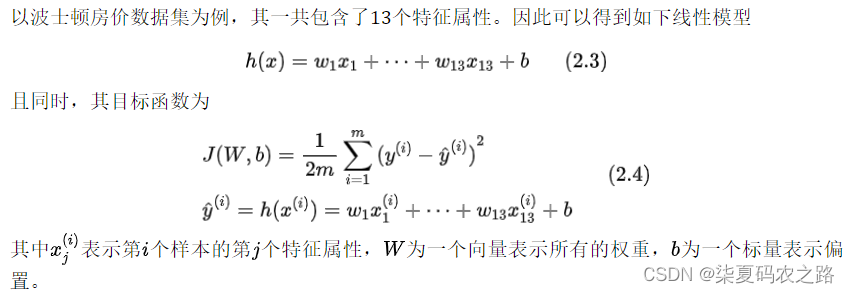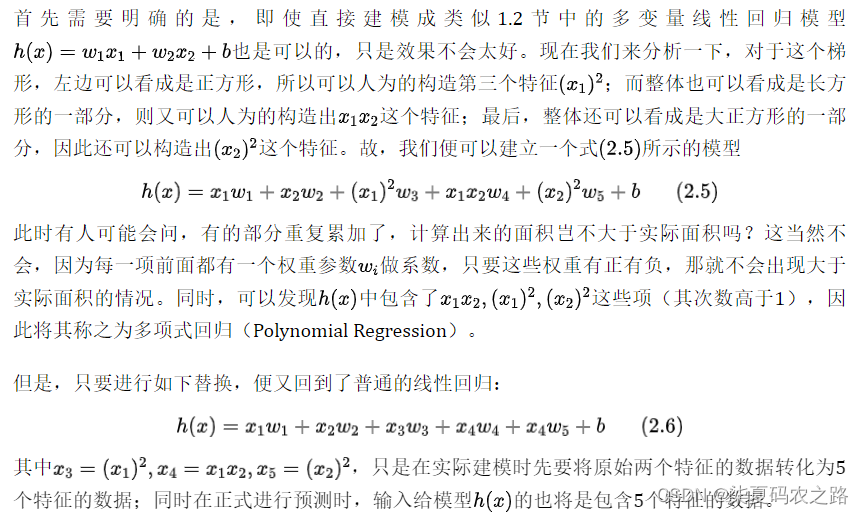1.线性回归模型
(1)了解线性回归模型
总体上呈现线性增长的趋势。如:房价预测




(2)sklearn简介
是一个开源的机器学习框架,例如线性回归、逻辑回归、决策树等等。
安装python包
pip install sklearn matplotlib线性回归示例代码
#导包
import numpy as np
from sklearn.linear_model import LinearRegression
import matplotlib.pyplot as plt
#制作样本 训练集
def make_data():
np.random.seed(20)
x = np.random.rand(100) * 30 + 50 # 面积
noise = np.random.rand(100) * 50 #加入一定的噪音(误差)
y = x * 8 - 127 - noise # 价格
return x,y
#定义模型并求解
def main(x, y):
model = LinearRegression() # 定义模型
x = np.reshape(x, (-1, 1)) #把x变成[n,1]的形状,至于n到底是多少,将通过np.reshape函数自己推导得出
model.fit(np.reshape(x, (-1, 1)), y)# 求解模型 用训练器数据拟合分类器模型
y_pre = model.predict(x) # 预测
print(y_pre)
#运行结果
if __name__ == '__main__':
x, y = make_data()
main(x, y) 2.多变量线性回归
包含有多个特征的线性回归就叫做多变量线性回归。
 代码示例:
代码示例:
#导入数据集
def load_data():
data = load_boston()
x = data.data
y = data.target
return x, y
#求解与结果(训练模型与输出相应的权重参数和预测值)
def train(x, y):
model = LinearRegression()
model.fit(x,y)
print("权重为:",model.coef_,"偏置为:",model.intercept_)
print("第12个房屋的预测和真实价格:",model.predict(x[12,:].reshape(1,-1)))
3.多项式回归

示例代码:
#1特征转化
from sklearn.preprocessing import PolynomialFeatures
a = [[3, 4], [2, 3]]
model = PolynomialFeatures(degree=2,include_bias=False) #degree表示变化维度2,include_bias是否添加一列全部等于1的偏置项
b = model.fit_transform(a) #对数据先进行拟合,然后标准化
print(b)
#2构造数据集
def make_data():
np.random.seed(10) #生成指定随机数
x1 = np.random.randint(5, 10, 50).reshape(50, 1)#根据参数中指定范围生成随机整数
x2 = np.random.randint(10, 16, 50).reshape(50, 1)
x,y = np.hstack((x1, x2)), 0.5 * (x1 + x2) * x1 #将参数元组的元素组按水平方向进行叠加
return x, y
#根据上述代码便得到了一个50行2列的样本数据,其中第一列为上底,第二列为下底。np.hstack的作用是将两个50行1列的向量合并成一个50行2列的矩阵。
#3建模求解与结果
def train(x, y):
poly = PolynomialFeatures(degree=2, include_bias=False) #PolynomialFeatures构建特征
x_mul = poly.fit_transform(x)
model = LinearRegression()
model.fit(x_mul, y)
print("权重为:", model.coef_)#[[0. 0. 0.5 0.5 0]]
print("偏置为:", model.intercept_) # [0.]4.回归模型评估
在回归任务(对连续值的预测)中,常见的评估指标(Metric)有平均绝对误差(Mean Absolute Error,MAE)、均方误差(Mean Square Error,MSE)、均方根误差(Root Mean Square Error,RMSE)、平均绝对百分比误差(Mean Absolute Percentage Error,MAPE)和决定系数(Coefficient of Determination),其中用得最为广泛的就是MAE和MSE。
(1)MAE平均绝对误差

def MAE(y, y_pre):
return np.mean(np.abs(y - y_pre))(2)MSE均方误差

def MSE(y, y_pre):
return np.mean((y - y_pre) ** 2)(3)RMSE均方根误差

def RMSE(y, y_pre):
return np.sqrt(MSE(y, y_pre))(4)MAPE平均绝对百分比误差

def MAPE(y, y_pre):
return np.mean(np.abs((y - y_pre) / y))(5)

def R2(y, y_pre):
u = np.sum((y - y_pre) ** 2)
v = np.sum((y - np.mean(y_pre)) ** 2)
return 1 - (u / v)回归指标示例代码
def train(x, y):
model = LinearRegression()
model.fit(x, y)
y_pre = model.predict(x) 5.梯度下降
梯度下降算法的目的是最小化目标函数,也就是一个求解的工具。当目标函数取到(或接近)全局最小值时,我们也就求解得到了模型所对应的参数。
 梯度下降完成代码:
梯度下降完成代码:
def cost_function(w1, w2):
J = w1 ** 2 + w2 ** 2 + 2 * w2 + 5
return J
def compute_gradient(w1, w2):
return [2 * w1, 2 * w2 + 2]
def gradient_descent():
w1, w2 = -2, 3
jump_points = [[w1, w2]]
costs = [cost_function(w1, w2)]
step = 0.1
print("P:({},{})".format(w1, w2), end=' ')
for i in range(20):
gradients = compute_gradient(w1, w2)
w1 = w1 - step * gradients[0]
w2 = w2 - step * gradients[1]
jump_points.append([w1, w2])
costs.append(cost_function(w1, w2))
print("P{}:({},{})".format(i + 1, round(w1, 3), round(w2, 3)), end=' ')
return jump_points, costs
if __name__ == '__main__':
jump_points, costs = gradient_descent()
plot_surface_and_jump_points(jump_points, costs)
以上信息均为自己的学习笔记,来源于网络!!
























 624
624











 被折叠的 条评论
为什么被折叠?
被折叠的 条评论
为什么被折叠?








